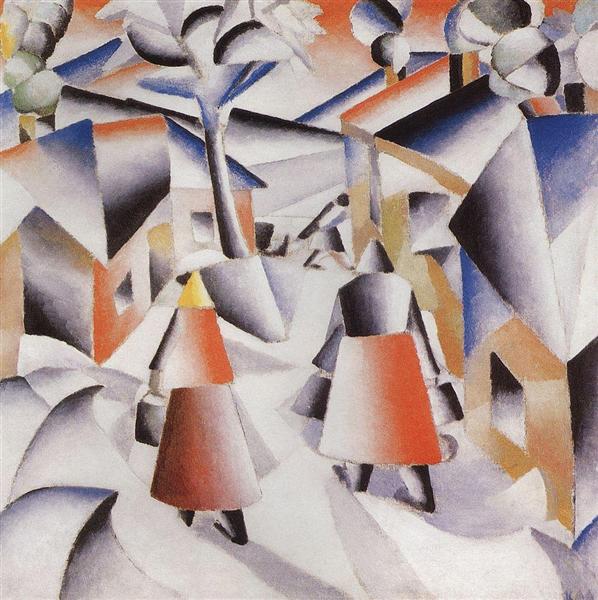Description
Kazimir Malevich, a pioneer of abstract art and founder of suprematism, offers us a captivating image of the Russian rural landscape in his 1913 work, "tomorrow in the town after a snowstorm." The painting, although framed within the period in which Malevich began to decompose the forms towards abstraction, still retains a figuration that reflects its artistic transit from the buffuturism towards its completely abstract style.
In "Tomorrow in the town after a snowstorm," Malevich creates a vibrant winter scene full of vitality and movement. The composition is articulated through geometric human figures and architectural structures that seem to balance in unison with the snowy atmosphere. The canvas is populated by several human figures that are dispersed throughout the foreground and the background, all wrapped in post-times daily activities. In the center on the left, a black figure seems to interact with another in brown and blue tones, while a white person who travels through the snowy landscape is glimpsed. The juxtaposition of these geometric figures with the rural environment intensifies the sensation of dynamism and community.
The colors in this work are especially significant. Malevich uses a palette dominated by the whites and gray of the snow, contrasted with the warm ocher and brown tones of the clothing and the constructions. This chromatic choice not only reinforces the winter theme, but also gives an almost cheerful essence to the scene, highlighting the luminescent aspects of dawn after the storm. Houses, hard lines and imprecise angles, acquire a cubist appearance that recalls Malevich's initial interest in the fusion of multiple perspectives, characteristic of Cubism.
The clear blue sky that opens over the people suggest a new day full of hope and renewal, a powerful symbol in Malevich's work that reflects its desire to transcend the mere visual representation and capture a more spiritual and universal essence. The way in which Malevich simplifies and geometry human and architectural forms anticipates its next step towards suprematism, a style that will embrace the purity of abstraction by using basic geometric shapes floating in a non -objective space.
This work is registered within the formative period of Malevich, when its experiments with cubofuturismo and its predilection for geometric shapes raided the path to the development of suprematism. Within this context, "tomorrow in the town after a snowstorm" can be considered a magnificent example of its search to simplify the shape and color, joining the everyday with the transcendental.
"Tomorrow in the town after a snowstorm" is not only a representation of life in a small Russian town after a snowfall, but also a reflection of Malevich's artistic transition. Through the geometrization of figures and the use of contrasting colors, Malevich manages to capture the essence of Russian rural life while opening to new artistic possibilities. This work is undoubtedly a prelude to the aesthetic revolution that Malevich would trigger with the advent of suprematism, laying the foundations for the transformation of modern art.
KUADROS ©, a famous paint on your wall.
Hand-made oil painting reproductions, with the quality of professional artists and the distinctive seal of KUADROS ©.
Art reproduction service with satisfaction guarantee. If you are not completely satisfied with the replica of your painting, we refund your money 100%.

